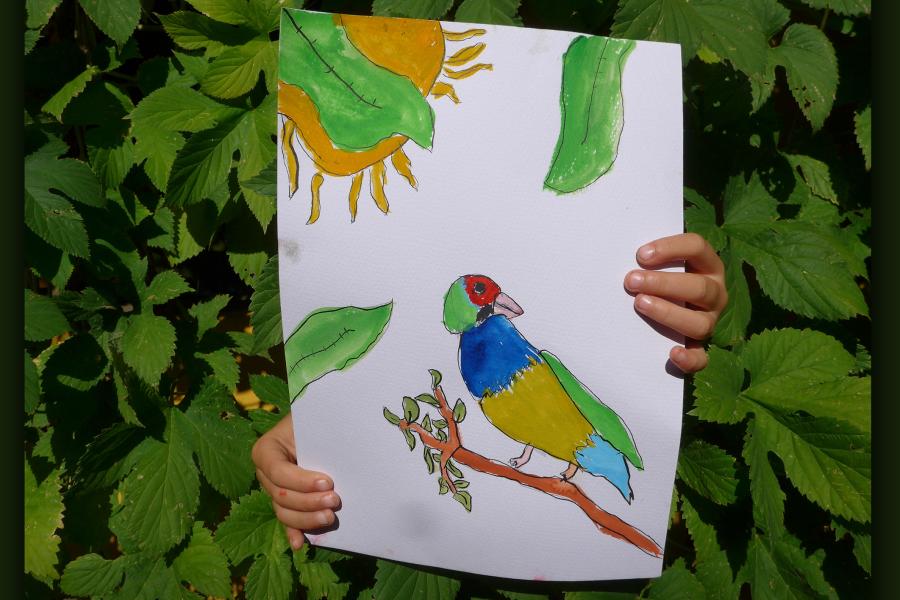Finch, 2025, Mirolima Lee Ström

Species: Gouldian finch (Chloebia gouldiae)
Location and habitat: Northern Australia
Conservation Status: Endangered (Australian Government EPBC), or Least Concerned (IUCN Red List)
Creator: Mirolima Lee Ström
Date: 2025
Medium: Watercolour and pen on paper
Photographer: Timothy Ström
Copyright: Used with permission.
I asked my six year old daughter to draw a bird for this project, and this is the result. In this photo, her watercolour-on-paper artwork is held in the sunshine, her little hands reaching through a hop vine that grows in our frontyard. I commissioned her for this -- remunerating her child labour with a local bookshop voucher -- as I wanted one of our 100 images drawn by a child. Children seem to devote much of their attention and imagination to thinking about, playing with and creating representations of animals. Perhaps children delight in such things are they are closer to the ground than adults, less drawn away into abstractions than adults.
I sat with Mirolima and a book of Australian birds, flicking through it seeking a specific species for her to draw (that also fit within the fairly complex balancing act of the choosing process). We settled on the Gouldian Finch, largely because of its stunningly beautiful colouring. Reading up on them, we learned that Gouldian Finches inhabit the North of Australia, living in open woodland and grasslands, never far from water, where they eat seeds, sometimes invertebrates and root in trees. They pair for a breeding season and nest in a loose colony structure, weaving grasses into a cup-shaped nest within specific kinds of hollows in specific Eucalyptus trees. Both parents incubate their eggs during the day, but only females at night. Males have a more purple breast, females more mauve. We also learned that Gouldian Finches were formally described in 1844 by the British ornithologist John Gould. He received a dead specimen from Benjamin Bynoe, the surgeon aboard HMS *Beagle*, the vessel most famous for carrying a young Charles Darwin around the world. He named this exquisite finch in memory of his wife and collaborator, the scientific artist Elizabeth Gould, who died at the age of 37 from a postpartum infection following her eighth childbirth, leaving behind six living children, and at least 650 remarkable illustrations of birds.
Mirolima was a keen student as we pieced together the above collection of facts, her sense of wonder seemingly insatiable. Back in 1956, Rachel Carson, the author of Silent Spring, wrote a delightful essay about the inborn sense of wonder that children have towards the natural world. She warned that this inborn disposition can wane as we grow up, being degraded by disenchantment, and flanked by a fixation on the artificial, with this alienation depriving us of our emotional understanding of the wonders of being part of our living planet. She encourages her readers, especially parents and carers, to actively encourage and foster children's inborn wonder at nature, living animals, as well as the non-living, rocks, clouds, the tide. She says advises:
"One way to open your eyes to unnoticed beauty is to ask yourself, ‘What if I had never seen this before? What if I knew I would never see it again?’”
This comment becomes even more poignant as the Sixth Mass Extinction grinds on.
Quotes
No quotes found.
Login to add a quote


